- 07 Mar 2024
- 12 Minutes to read
- Print
- DarkLight
Automation Manager (AM) Trigger Conversions
- Updated on 07 Mar 2024
- 12 Minutes to read
- Print
- DarkLight
Abstract
Automation Manager (AM) Trigger Conversions
Automation Manager triggers are retired as RAM triggers can be built to replace them. RAM triggers offer multiple benefits over AM triggers such as log details, email alerts, retry logic, and better monitoring. The information shows how you can create a RAM trigger comparable to what was previously available in Automation Manager. Each section includes the following information:
The name of the retired Automation Manager Trigger.
A screen capture example of what the Automation Manager Trigger used to look like.
An example of how to create a RAM Trigger comparable to the retired Automation Manager Trigger.
A screen capture of the example RAM Trigger.
A summary of how to read the RAM Trigger.
a
Examples of extra conditions to add to the RAM Trigger.
1. Update HR Status Across all Reqs for Candidate in Final Status
Definition and Example
This Automation Manager trigger used to automatically update a candidate to a designated final status across all Open or On Hold requisitions that they were filed to after they are updated to a Hired status. This ensures that all impacted req team members no longer consider the candidate for other reqs. The trigger runs on an hourly basis. Notifications are also sent to configured recipients when the trigger updates any candidates they are working with.


Creating a RAM Trigger comparable to this Automation Manager Trigger Type
Triggering Mechanism: HR Status Req Options
Triggering Event: Hired (or another Final ‘hired’ Status)
Delay Mechanism: Delay Triggering
Trigger Delay (hrs): 1
Trigger Context: Run trigger across reqs.
Rule 1: This rule updates the candidate that was hired to a final or disposition status across the other reqs they applied to. Checking whether the candidate is in a start or intermediate status for the other reqs, and checking whether the req is in an Open status.
Conditions:
HR Status: select all start and intermediate statuses.
Req Status: Open.
Actions:
Send Communication to the Req team. AM forced a communication to be sent – RAM has the flexibility to not send.
Update HR Status to your designated HR Status (for example: “Hired to Another Req”). Select “Update across all active reqs in all req templates”.
Rule 2: This rule updates the candidate that was hired to a final or disposition status across the other reqs they applied to. Checking whether the candidate is in a start/intermediate status for the other reqs, and checking whether the req is in an On Hold status.
Conditions:
HR Status: select all start and intermediate statuses.
Req Status: On Hold.
Actions:
Send Communication to the Req team. AM forced a communication to be sent – RAM has the flexibility to not send.
Update HR Status to your designated HR Status (for example: “Hired to Another Req”). Select Update across all active reqs in all req templates.
Example
In the example RAM, a candidate has applied to req A, B, and C. The candidate is moved to a Hired status for req A. This candidate is still active in the recruitment process for the other reqs, and at an intermediate status. After the candidate is moved to a Hired status for req A, RAM runs, and reviews the candidate against Rule 1. If the candidate is in one of the defined intermediate HR statuses for req B or C, and the Req Status is Open, the RAM sends a communication to the req team for reqs B, C, or both and then update the candidate’s HR status to Hired to Another Req. If the candidate did not meet the conditions for Rule 1, Rule 2 runs. If the candidate is in one of the defined intermediate HR statuses for req B or C, and the Req Status is On Hold, the RAM sends a communication to the req team for reqs B, C, or both, and then updates the candidate’s HR status to Hired to Another Req.


Extra conditions and actions that can be added to the Rules of the RAM
Checking for a specific Candidate Type.
Checking for the req to be created with a specific Req Template.
Checking for specific req form field options to be selected.
Checking for specific candidate form field options to be selected.
Send a communication to the candidate for the other reqs they are dispositioned against.
Populate a disposition form on the candidate’s Talent Record.
2. Candidate HR Status – Send Talent Record
Definition and Example
This notification trigger is used to send a candidate’s Talent Record to designated internal users based on a change to a configured HR Status. The trigger is configured to include forms to view or complete by using existing eLink functions. This trigger runs daily at regular intervals throughout the day, at least once per hour.
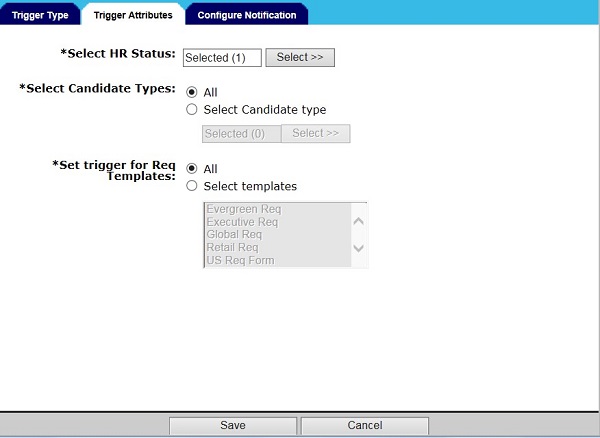
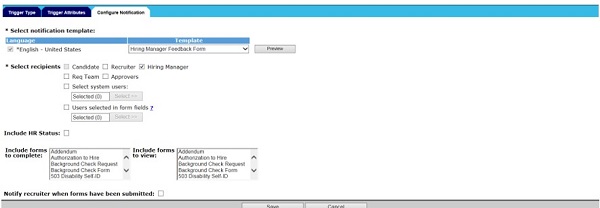
Creating a Communication Template that is used in the RAM Trigger
Select the forms as needed. Do not add tokens into the body of the message.
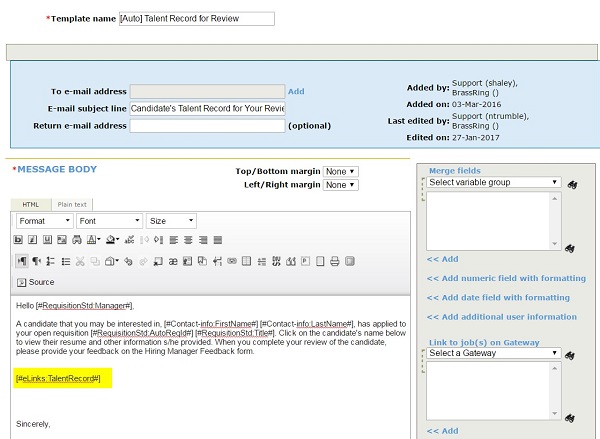
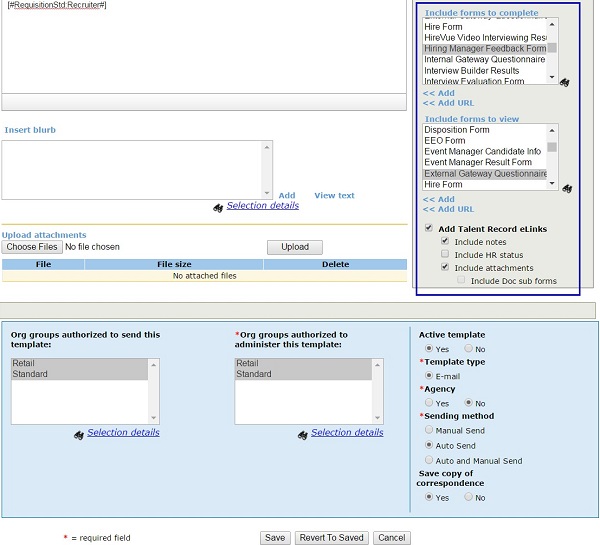
Creating a RAM Trigger comparable to this Automation Manager Trigger Type:
Triggering Mechanism: HR Status
Triggering Event: Hiring Manager Review, or another HR Status that starts the email, including the Talent Record of the candidate.
Delay Mechanism: Delayed Processing.
Trigger Delay (hrs): 0.
Trigger Context: NA.
Rule 1: This rule sends an email to the user of your choice. The email contains a link to the candidate’s Talent Record and any forms that have been indicated to complete or view.
Conditions: None.
Actions: Send Communication to the user of your choice
Example
In the RAM example, the wanted action is to send a candidate’s Talent Record to the Hiring Manager when they are moved to Hiring Manager Review, so the Manager can review the candidate’s information and provide feedback. After the candidate is moved to a Hiring Manager Review HR status, Rule 1 runs. Since there are no conditions, the action is taken to send an email to the Hiring Manager selected on the req.
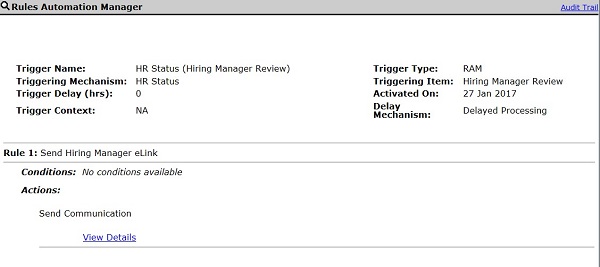
Extra conditions and actions that can be added to the Rules of your RAM:
Checking for a specific Candidate Type.
Checking for the req to be created with a specific Req Template.
Another RAM trigger to notify the Recruiter when the forms are completed.
3. HR Status Update – Notify Candidate
Definition and Example:
This notification trigger sent the candidate an email message based on changes to their HR Status within a req folder. This trigger’s notification was configured within the BrassRing communications template module with all existing email merge fields available. This trigger ran daily at regular intervals throughout the day, at least once per hour.


Creating a RAM Trigger comparable to this Automation Manager Trigger Type:
Triggering Mechanism: HR Status
Triggering Event: Background Check complete
Delay Mechanism: Delay Triggering
Trigger Delay (hrs): 1 (values in 1-hour increments can be used) to add a delay in the trigger running.
Trigger Context: NA
Rule 1: This rule sends a notification email to the selected users informing them that the background check is complete when the HR status is updated to Background check complete.
Conditions:
HR Status: select wanted HR status. In this case Background Check complete.
Candidate Type: select the applicable candidate types for the trigger condition logic.
Req template: select the applicable req templates for the trigger condition logic.
Form field Value: select the applicable form field value for the trigger condition logic.
Actions: Send Communication to the selected recipients
Example
In the RAM example, the wanted action is to send an email to a defined user when they are moved to Background Check Complete, so the user is informed of the status change and can take actions in external systems if necessary. After the candidate is moved to a Background Check Complete HR status, Rule 1 runs. If the candidate is in the defined HR Status, has the defined candidate type, has been moved to this status on a req that was created with a specific req template, and has specific field data that has been filled out, the Rule completes the action. The RAM’s action sends out a communication to a defined user that the Background Check has been completed.

Extra conditions and actions that can be added to the Rules of your RAM:
Checking for specific req form field options to be selected.
Checking for specific candidate form field options to be selected.
Populate another candidate form on the candidate’s Talent Record.
4. Req Aging
Definition and Example
This notification trigger sent the designated internal users an email message to notify them of requisitions that were over the designated time periods. The merge fields for this trigger were configured within Automation Manager and appeared in an HTML table on the configured communication template’s message. The trigger might be configured for various aging periods and might be configured for time periods outside the normal requisition age. This trigger ran once daily sending notices at 6:00 AM EST.

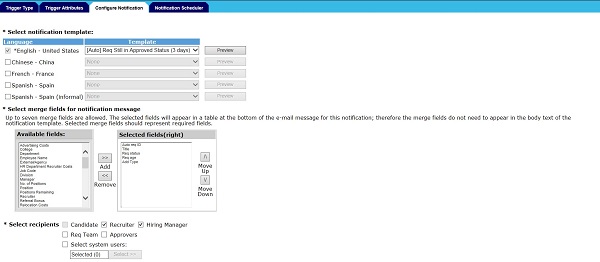


Creating a RAM Trigger comparable to this Automation Manager Trigger Type:
Triggering Mechanism: Req Approved.
Select only one req status per trigger, each status must be configured in a separate RAM. Optional req Statuses to build a trigger include: Req Approved, Req Cancelled, Req Closed, Req Create, Req Declined, Req Deleted, Req Edit, Req on Hold, Req Open. Req Pending is not currently available.
Triggering Event: Select the wanted req template. You can select one req template per RAM trigger. For each req template, you must configure a separate RAM trigger.
Delay Mechanism: Aging. Aging is used to check for req status aging. If a req status change has occurred and the trigger delay type is Aging, RAM will check whether the req status is the same after the delay period has expired. If the status is still the same, the trigger is fired and run. With this new delay mechanism, multiple triggers can be set up by using the same trigger event, but different value for 'Trigger delay (hrs)'.
Example: Req status change has occurred and the RAM trigger has been configured for Trigger delay type as 'Aging' with trigger delay of 48 hours. In this case, RAM will check after 48 hours if the Req status is still the same, the trigger will be fired and run.
Trigger Delay (hrs): Enter the delay timeframe, in hours. Only positive, whole numbers might be used. Currently, RAM does not allow a range of days like Automation Manager did. If you would like to set up a ‘range’ of days, multiple RAM triggers are required.
Trigger Context: NA
Rule 1: This rule sends a notification email to the selected users informing them that the Req status has not changed.
Conditions: None.
Actions: Send Communication: Select the wanted recipients of the communication.
Example
In the RAM example, a communication is sent out after the req (created with a defined req form) is in an Approved status for three days. After the req has completed the approval process, the req moves to an Approved status. The RAM trigger waits the allotted 3-day delay. After the 3-day delay, the RAM will check to see whether the req is still in an Approved status. If so, the RAM sends a communication to the Recruiter and Hiring Manager that is listed on the req. This communication is a reminder for them to log in to BrassRing to Open and post their req.

Extra conditions and actions that can be added to the Rules of your RAM:
Checking for specific req form field options to be selected.
Link to Existing Rules.
Check for Req Status.
Populate field Values (Req Subsidiary form).
Run another instance.
Exit.
5. Candidate HR Status Aging
Definition and Example:
This notification trigger sent the designated internal users an email message to notify them of candidates that are sitting idle in a starting or intermediate HR status. The merge fields for this trigger were configured within Automation Manager and appeared in an HTML table on the configured email template’s message. The trigger was able to be configured for various aging period, applies to candidates in req folders for Open or On Hold requisitions, and ran once daily sending notices at 6:00 AM EST.

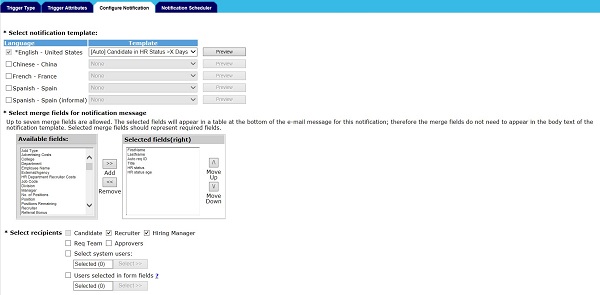


Creating a RAM Trigger comparable to this Automation Manager Trigger Type:
Triggering Mechanism: HR Status
Triggering Event: Select the wanted HR Status.
Delay Mechanism: Aging.
Aging is used to check for HR status aging. If an HR status change has occurred and the trigger delay type is 'Aging', RAM will check to see whether the HR status is the same after the delay period has expired. If the status is still the same, the trigger is fired and run. With this new delay mechanism, multiple triggers can be set up by using the same trigger event, but a different value for Trigger delay (hrs) is required.
Example: HR Status change has occurred and the RAM trigger has been configured with the Trigger delay type 'Aging', with trigger delay of 48 hours. In this case, RAM will check after 48 hours and if the HR status is still the same the trigger is fired and run.
Trigger Delay (hrs): Enter the delay timeframe, in hours. Note: Only positive, whole numbers might be used.
Trigger Context: NA
Rule 1: This rule sends a notification email to the selected users informing them that the HR status has not changed.
Conditions: None
Actions: Send Communication: Select the recipients of the communication.
Example
In the RAM example, a communication is sent out after the candidate has been in an Offer Extended HR status for 3 days. After the candidate is moved to an Offer Extended HR status, the RAM trigger waits the allotted 3-day delay. When the 3-day delay has passed, the RAM checks to see whether the candidate is still in an Offer Extended status. If so, the RAM sends a communication to the Recruiter and Hiring Manager that is listed on the req. This communication is a reminder for them to contact the candidate about the pending offer.

6. Talent Record Viewed – update HR Status
Definition and Example:
This automation trigger updates a candidate’s HR Status to a designated start status when the Talent Record is viewed/opened. This trigger runs daily at regular intervals throughout the day, at least once/hour and applies to requisitions are Open or On Hold.
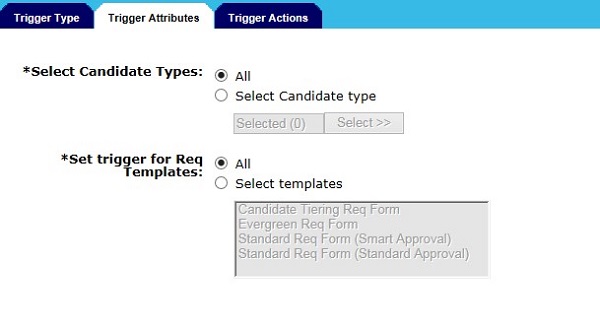

Creating a RAM Trigger comparable to this Automation Manager Trigger Type:
Triggering Mechanism: Talent Record Viewed
Triggering Event: Select the wanted req templates.
Delay Mechanism: Delayed Triggering
Trigger Delay (hrs): Enter the delay timeframe, in hours. Note: Only positive, whole numbers might be used and the minimum delay is 1 hour.
Trigger Context: NA
Rule 1: This rule updates the candidate to a designated HR Status.
Conditions: None
Actions: Update HR Status – Update the candidate to a designated HR Status. It is recommended to update the candidate to a Start of Intermediate status. Notes: The Automation Manager trigger only had the capability of updating candidates from 0-filed to a Start status. RAM allows the updating the candidate from Start statuses other than 0-filed. If the client setting “ByPass ClosedLogic when Updating HRStatus in RAM” is enabled, it is recommended to review the workflow and process. This RAM trigger might update candidates to a status that is not wanted.
Example
In the RAM example, the candidate is filed into the req at the start status (defined on the req template level). The Recruiter opens their req folder in BrassRing. The req was created with a req template that is selected in the RAM trigger (Triggering Event field). The Recruiter then selects the candidate’s name in BrassRing to open the Talent Record. 1 hour after the Recruiter opened the Talent Record, the RAM trigger runs, and the candidate is updated to a Recruiter Reviewed HR status.

Extra conditions and actions that can be added to the Rules of your RAM:
Condition to look at only candidates in a specific candidate type.
Populate field values on a candidate form.
